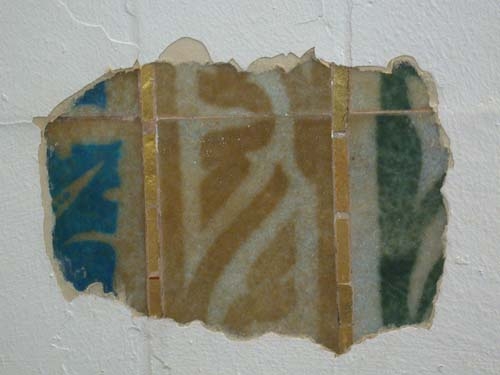|
The Revealing - June 2003
On Thursday 17th April 2003 some cracks were found on the east wall of the chapel just above the altar. Flakes of paint had become detached revealing something that appeared to be mother-of-pearl in what later was discovered to be the halo of the left angel. An investigation was launched by the chapel wardens, Matthew Feldwick and Vicky White into what lay behind the layers of paint and paper. In the history of the college a rather fuzzy picture of the chapel in the 1920's was found which showed an ornate reredos and what looked like two figures on either side of the altar. Little could be made of these pictures however so it was decided to reveal part of each angel so as to find out more. This restoration work, which took about three hours per square foot, has been done using advice given by the Tiles and Architectural Ceramics Society (TACS). In a rather strange coincidence it was latterly found out that the revealing work was done exactly 98 years after the pieces were first commissioned!
|
 A History
A History
Researching the history of the chapel angels has been rather difficult as relevant information from the college records is either missing or deeply buried. However, the records complied by Dr Dennis Hadley showing the Opus Sectile works of Powell's of Whitefriars have revealed the following information:
24/4/05 Training College Chapel Winchester, Reredos, Opus Sectile, includes kneeling angels, 92-10-0.
This sum of money is worth about 5,700 in today's buying terms. |
|
We are still unsure as to the exact time the angels were covered over.
There are pictures that appear to have been taken in the 1950's when the old stone/wood altar was removed and a new, modern replacement was installed. At this point the present candle brackets were also mounted on the wall.
Restoration work has revealed that there are three layers of paint on the wall which would confirm this time of covering.
There could be any number of reasons as to why they were covered ranging from a personal dislike of them by a previous incumbent - their gaudiness not finding favour to them going out of fashion and been painted over in an attempt to modernise the building. One such case would be Headbourne Worthy church which has ornate tiles hidden under paint in the chancel also waiting to be discovered. The tiles could also be damaged in an area although so far nothing suggests this. There were also serious disputes between the Chaplain and the Principal at this time.
|
|
A Description
Whitefriars produced hand made glass which was exported throughout Europe; which is still collectable. James Powell's grandson, Harry took over the factory on the death of his grandfather in 1875 and expanded the company's operations.
It was Harry who developed the mosaic side of the business. He was concerned about some glass produced in his foundry which had become contaminated. He discovered that it was tiny specks of clay from the crucibles in which the glass was melted that was causing this contamination. He experimented and found that this waste glass could be ground to a powder and baked. This would produce a solid material with an eggshell surface, which could be used for mosaics. The range of colours was almost unlimited.
These mosaics are made in a style known as Opus Sectile, meaning 'one piece'. Although some of the backgrounds are made with small, regular pieces of glass, the figures are made of larger, irregular pieces. So an angel's wing or a fold in a robe might be one piece of mosaic.
The design of these angels and their faces are based on Rossetti and Burne-Jones figures. These two artists were commissioned to produce the originals and some of the more important assignments such as St. Paul's Cathedral, were also painted by them. Judging by the quality of the angelic faces in the chapel they are either the work of one of these pre-Raphaelite masters or a very close copy of them from cartoons kept in Powell's archives.
Both of the angels are connected with the Eucharist service. The figure on the left is kneeling with a sheaf of wheat symbolising the bread and thus the body of Christ, whilst the angel on the right is holding a vine representing wine and consequently the blood of Christ.
They are both on a background of gold mosaic known as smalti which is highly unusual and are set within decorated tiles that extend the whole length of the wall. These tiles are also unusual as no record of similar styles has yet been found. I expect that when more research has been conducted into these we will have a treasure that is of as much importance as the angels themselves.
Underneath each respective angel there is the inscription of "I am the living bread," and, "I am the true vine," although the latter has yet to be revealed. The main inscription that runs along the bottom of the wall is a dedication of the work to the wife and son of Henry Martin, who was principal of this college from 1876 to 1912.
Some of the opus sectile work was lost during the re-ordering of the chapel in the 1950's. This includes a further inscription and four cherub heads either side of the east window. However, photographic evidence to date is rather limited.
|
|


